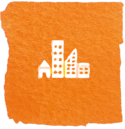More green and blue in cities to enhance liveability

Article from the Info Day Magazine 2023
There are many challenges that face cities in the era of climate change and rising population density, including heatwaves, floods, water shortages, loss of biodiversity and increasing demand for energy. Eawag is researching how these problems could be mitigated using blue-green infrastructure.
“This is Lamb’s Ear, a plant with very special properties,” says Lauren Cook, running her hand across the soft, white-haired leaves. The nondescript herbaceous plant extends like a lightly coloured carpet across a sort of table – one of four model roofs that Cook and her team have built on a terrace at ETH Zurich’s Hönggerberg campus. Cook is an environmental engineer in Eawag’s Urban Water Management department, where she leads a research group on blue-green infrastructure. This includes a wide range of natural structures within the built environment: parks and brownfield sites, planted traffic islands, groups of trees, ponds, springs and streams, vertical gardens and green roofs. Cook’s experimental model roofs each have a different surface. Three are planted with different species of plant – one with Lamb’s Ear, another with Common Catchfly, and another with Stonecrop, a succulent that is something of a classic in roof-planting schemes. Meanwhile, the surface of model number four – the control roof – has been modified over the course of the experiment: from black foil to gravel to lightly coloured panels of rock wool. Each of these miniature roofs is also fitted with a vertical, double-sided solar panel – and with various sensors that relay data relating to the soil temperature and moisture content, the transpiration rates of the plants, and the temperature and energy output of the solar panels at five-minute intervals. “Our aim was to find out how different green roofs affect the roof temperature and the energy yield of the solar panels,” explains Cook.
The cooler and brighter, the more solar power
In this context, it’s important to bear a few things in mind: first, plants reduce the temperature of their surroundings through transpiration (the evaporation of water); second, pale-coloured surfaces reflect radiation more strongly than dark ones and heat up less as a result; and, third, high temperatures reduce the output of photovoltaic modules – the cooler the modules, the higher their efficiency. As vertical solar panels can also absorb radiation reflected by the roof, they benefit from a light surface colour. Would a green roof cover consisting of the pale-coloured Lamb’s Ear be the ideal solution for achieving less heat and more solar power? “In fact, it wasn’t the roof covered with the Lamb’s Ear, but the one with Common Catchfly that performed best in terms of electricity yield, although there are only small differences,” says Cook. Compared to the black roof, however, all of the green roofs boosted the solar panel’s output – on some days by as much as 20 per cent. “Green roofs are superior to conventional roofs because they’re multifunctional,” says the environmental engineer. They are able not only to reduce heat and therefore boost the output of solar panels, but they also promote biodiversity. This summer, Kilian Perrelet, a PhD student in Cook’s group, carried out research on green roofs in the city of Zurich to determine just how many different insects and tiny invertebrates these roofs accommodate. What’s more, green roofs and other types of blue-green infrastructure absorb and store water – a vital characteristic in times of climate change.
As well as heat, the increasing bouts of heavy rain lead to problems in the built environment – here, the issue is what is known as combined sewer overflow. To prevent wastewater treatment plants from becoming overloaded when it rains, storm overflows collect what is known as combined sewage – a mixture of rainwater and untreated wastewater. If it rains heavily, however, these pools can overflow, causing untreated combined sewage to flow directly into lakes and rivers and pollute the ecosystem. This combined sewer overflow – along with many other hydrological processes – can be followed in real time in Fehraltorf, a town of 6,500 inhabitants to the east of Zurich where Eawag set up an “Urban Water Observatory” in collaboration with ETH Zurich in 2015. Here, a monitoring network consisting of over 100 sensors supplies continuous data relating to the urban water cycle – on runoff, moisture content, flow speed, the fill level of storm overflows, precipitation intensity and temperature. “For example, we can use this data to model how many and which types of blue-green infrastructure would be necessary to absorb rain so that combined sewer overflow no longer features in future precipitation scenarios in Fehraltorf,” explains Cook. If 30 per cent of the settlement and industrial area of Fehraltorf were covered with blue-green infrastructure, the model indicates that combined sewer overflow could be reduced by over 80 per cent.
Giving greater thought to multifunctional effects
The Eawag researcher and her team would like a range of factors – stormwater management, cooling, improvement of photovoltaic output, and habitat for plants and animals – to be considered in an approach that allows blue-green infrastructure to be evaluated with regard to its various functions, taking account of climate data and scenarios. “So far, this kind of holistic view has been missing,” says Cook. People put a green roof here to collect water and a few trees there to provide shade. “But not enough thought is given to the synergies between different elements and their multifunctional effects,” says the environmental engineer. “We need more and better-connected blue-green infrastructure if our cities are to be resilient and liveable in the future. Our research is helping engineers and urban developers with their planning and decision-making.” This applies whether it’s about finding the optimum combination of green and blue elements for the neighbourhood in question or making individual structures such as green roofs even more efficient and multifunctional through better design and a better thought-out selection of plants.
A contribution to the SDGs:



Created by Isabel Plana for the Info Day Magazine 2023


